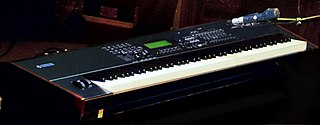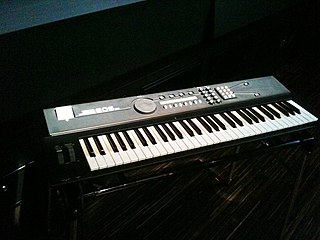
Ensoniq ESQ-1 is a 61-key, velocity sensitive, eight-note polyphonic and multitimbral synthesizer released by Ensoniq in 1985. It was marketed as a "digital wave synthesizer" but was an early Music Workstation. Although its voice generation is typically subtractive in much the same fashion as most analog synthesizers that preceded it, its oscillators are neither voltage nor "digitally controlled", but true digital oscillators, provided by a custom Ensoniq wavetable chip. The signal path includes analog resonant low-pass filters and an analog amplifier.
The Yamaha AN1x is a DSP-based analog modeling synthesizer, produced by Yamaha Corporation from 1997 to 1998, and was marketed as an "analog physical modelling control synthesizer".
Phase distortion (PD) synthesis is a synthesis method introduced in 1984 by Casio in its CZ range of synthesizers. In outline, it is similar to phase modulation synthesis as championed by Yamaha Corporation, in the sense that both methods dynamically change the harmonic content of a carrier waveform by influence of another waveform (modulator) in the time domain. However, the application and results of the two methods are quite distinct.

The Korg OASYS is a workstation synthesizer released in early 2005, 1 year after the successful Korg Triton Extreme. Unlike the Triton series, the OASYS uses a custom Linux operating system that was designed to be arbitrarily expandable via software updates, with its functionality limited only by the PC-like hardware.

The Access Virus is a virtual analog synthesizer made by the German company Access Music GmbH. It was first produced in 1997 and has since been upgraded frequently, with the company releasing new models about every two years. Early models include the Virus A, Virus B, and Virus C series, each available in various hardware configurations. In November 2005, the Virus TI series was released, including the 61-key Virus TI Keyboard and the 37-key Virus TI Polar. A small desktop model was released in February 2008 called the Virus TI Snow. A revision of the TI series called TI2 came out in March 2009, featuring faster digital signal processing (DSP) controllers, additional polyphony, more effects in the effect section and a slightly changed design. The Virus series also has come out with two software plugin versions: TDM for Pro Tools and VST for TC Electronic Powercore series. The term Access Virus can be used to refer to any one of these synthesizers. In 2024 Access Music discontinued the TI2.
The Yamaha SY85 is a digital music workstation introduced in 1992. Unlike other Yamaha synthesizers of the time the SY85 does not use FM synthesis. Instead, its sounds are based on samples, which can be layered and modified to create new sounds.
Linear arithmetic synthesis, or LAsynthesis, is a means of sound synthesis invented by the Roland Corporation when they released their D-50 synthesizer in 1987.
The Novation SuperNova, released in 1998, was a 3U rack-mounted virtual analogue polyphonic synthesizer with 16+ note polyphony and multitimbral operation, made by the British company Novation. Unique to the Supernova was the addition of multiple effects options which were retained per part in multi-timbral use, allowing a much richer sound than had generally been possible with a multitimbral synthesizer. The SuperNova and its successor, the SuperNova II, have been used by a wide range of artists including Orbital, ATB, The Faint, Ozric Tentacles, Sin, Jean-Michel Jarre and A Guy Called Gerald.
The Yamaha V50 is a hybrid music workstation introduced in 1989. It combines a sequencer, rhythm machine, an FM synthesis-based sound module and a MIDI keyboard.

The Korg DSS-1 is a polyphonic sampling synthesizer released by Korg in 1986. As Korg's initial entry into the sampling market, the DSS-1 combines sampling, additive synthesis, and waveform drawing with an analog signal path. The DSS-1 was released a time when major synthesizer manufacturers like Yamaha and Casio were beginning to explore sampling, an area of sound design dominated by companies like Fairlight, E-mu, and Ensoniq. Korg did not stay long in the sampling arena; the DSS-1 was the company's only sampler until 1998 when Korg introduced sampling options on their Triton and Trinity series of workstations.

Yamaha SY77 is a 16 voice multitimbral music workstation first produced by Yamaha Corporation in 1989. The SY77 is a synthesizer whose architecture combines AFM synthesis, AWM2 for ROM-borne sample-based synthesis, and the combination of these two methods christened Realtime Convolution and Modulation Synthesis (RCM). The same technology was also packaged in a rack-mounted module released simultaneously, the TG77.
The Roland JD-990 Super JD is an updated version of the Roland JD-800 synthesizer in the form of a module with expanded capabilities, which was released in 1993 by Roland Corporation. JD-990 is a multitimbral synthesizer utilising PCM sample-based synthesis technology. In a sense it is not a true module version of a JD-800 as it has many expanded features and as a result the two are incompatible in exchanging presets. It is equipped with 6 MB of ROM containing sampled PCM waveforms, four sets of stereo outputs that are assignable to individual, internal, instruments, and standard MIDI in/out/through ports. JD-990 has a large LCD display and programming takes place through a keypad on the front panel of the unit. The unit can generate multi-timbral sounds reminiscent of the vintage analogue synthesizers but is also capable of generation of modern digital textures. There are several expansion boards available for JD-990 that can be installed in the provided expansion slot in the chassis of the unit.

A synthesizer is an electronic musical instrument that generates audio signals. Synthesizers typically create sounds by generating waveforms through methods including subtractive synthesis, additive synthesis and frequency modulation synthesis. These sounds may be altered by components such as filters, which cut or boost frequencies; envelopes, which control articulation, or how notes begin and end; and low-frequency oscillators, which modulate parameters such as pitch, volume, or filter characteristics affecting timbre. Synthesizers are typically played with keyboards or controlled by sequencers, software or other instruments, and may be synchronized to other equipment via MIDI.
The Yamaha SY99 is a synthesiser combining frequency modulation synthesis and sample-based synthesis and the direct successor to Yamaha's SY77/TG77. Compared to the SY77, it has a larger keyboard at 76 keys instead of 61, a larger ROM with more in-built AWM samples, the ability to load user-specified AWM samples into on-board RAM, an upgraded effects processor, and several other enhanced features.
The Alesis Quadrasynth is a 76-key, 64-note polyphonic PCM sample-based digital subtractive synthesizer first introduced in 1993. It was Alesis's first major foray into synthesizer production.

The Yamaha Music SynthesizerS90 is a synthesizer and a MIDI controller in one unit, released in 2002 to supersede the S80. As such, it is part of the S series together with the S03 and S08. It was superseded by the S90ES in 2005, itself superseded by the S90XS in 2009.

The PPG Wave is a series of synthesizers built by the German company Palm Products GmbH from 1981 to 1987.

The CZ series is a family of low-cost phase distortion synthesizers produced by Casio beginning in 1985. Eight models of CZ synthesizers were released: the CZ-101, CZ-230S, CZ-1000, CZ-2000S, CZ-2600S, CZ-3000, CZ-5000, and the CZ-1. Additionally, the home-keyboard model CT-6500 used 48 phase distortion presets. The CZ series was priced affordably while having professional features. In the same year Yamaha released their low-cost FM synthesizers, including the DX-21 and Yamaha DX100 which cost nearly twice as much.

The Yamaha YS200 is an FM synthesiser and workstation produced by Yamaha, introduced in 1988. It combines a sequencer, rhythm machine, an FM synthesis soundchip and a MIDI keyboard. It was called the EOS YS200 in Japan and was also released as a more home-oriented keyboard in the form of the Yamaha EOS B200, which also featured built-in stereo speakers. The YS200 is the keyboard equivalent of the Yamaha TQ5 module. The forerunner of the YS200 was the almost-identical Yamaha YS100.

The Korg Z1 is a digital synthesizer released by Korg in 1997. The Z1 built upon the foundation set by the monophonic Prophecy released two years prior by offering 12-note polyphony and featuring expanded oscillator options, a polyphonic arpeggiator and an XY touchpad for enhanced performance interaction. It was the world's first multitimbral physical modelling synthesizer.











